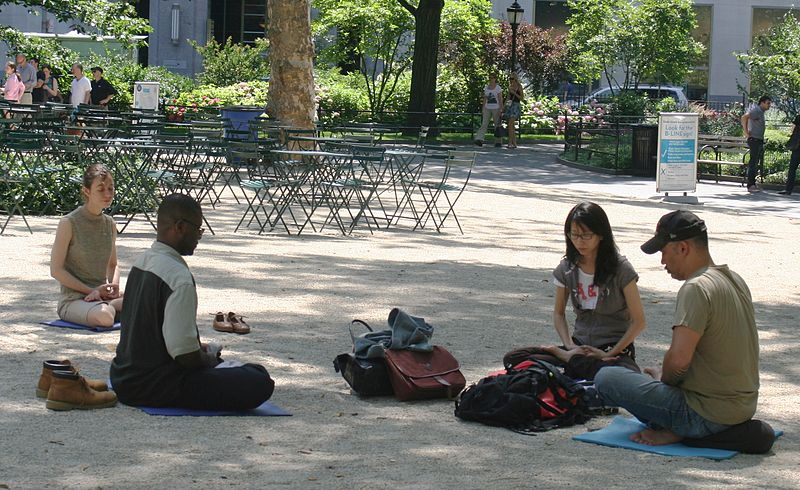
Suggested key practice
to re-balance our tendency to ‘live in our heads’ and bring us back to
now
and to wholeness –
mindfully:
Many of us long for the happiness of at-one-ment .
We also long to reduce the pull of the lower self. How?
By staying ‘awake’ more. How? Through mindfulness.
How? a) Creating short periods of stillness and silence
b) staying conscious of the breath, c) as thoughts and feelings arise acknowledge them but don’t fight or chase them – say “Hello – thank-you – goodbye.”
If things stop or get interrupted just go back to stillness and the conscious breathing.
“Breathing in I know that I’m breathing in.” “Breathing out
I know that I’m breathing out.”
“Smile: Breathe: Go slowly.”
– Zen master – Thich Nhat Hanh
RECOMMENDED BOOKS & VIDEOS: Books non-religious 1) One Moment Meditation – stillness for people on the go by Martin Boroson, Mindfulness: a practical guide to finding peace in a frantic world (INCLUDES A CD) by Mark Williams & Danny Penman.
VIDEOS: Buddhist – just put ‘Thich Nhat Hanh’ into YouTube!
-0-
MEDITATION – Vipassana – Professor Shrader’s teaching plus two suggestions from RP
Below is the couple of sections in which is the form of meditation that Prof, Shrader teachers his university students – in the time it takes to change classes!
TWO NOTES from RP
i) I would say do what he says but start with Breathing in I know that I’m breathing in, Breathing out I know that I’m breathing out – ….. Tolle says several short sessions during the day, minutes or even seconds are better than one long one – especially if you tend to fall asleep!
ii) I also remember a teaching, and use it. When a thought or feeling arises say. “Hello – thank you – and goodbye!”
Prof Shrader’s instruction is as follows:
Sit up straight. Rest your hands lightly in your lap or on your knees. Do not close your eyes entirely, but let your lids relax so that the eyes become half-closed/half-open.
Without moving your head, lower your gaze to approximately 30˚ below the horizon.
Do not look at anything in particular. Do not think about anything in particular. Do not worry about anything in particular.
As thought come to your mind, as they surely will, simply acknowledge them and let them pass. Do not follow them. Do not try to suppress them so as to have a blank mind. Simply observe and let them pass. So too with feelings or emotions. Acknowledge them for what they are. Accept their presence. Do not try to suppress them, but do not follow them. Let them pass.
We sit silently for five minutes. For some students, it seems like an eternity. They shift nervously in their seats, occasionally opening their eyes a bit wider or turning their head to see if anyone is looking at them. At the end of the allotted time, I instruct them to slowly open their eyes and gradually return to a consciousness of the room in which we sit. I ask:
So how do you feel? Rested? Relaxed? Calm? Energized? Centered? Focused? Do things look and feel a little differently than they did five minutes ago? Do you find yourself becoming acutely aware of details in this room that had heretofore escaped your attention? Are you perhaps more aware of – do you perhaps even feel more connected to – the people who occupy a space adjacent to your own? If you answered “yes” to any of these questions, you have caught a glimpse of the power of vipassana.
In its simplest form, vipassana cries “timeout” to the stream of cognition and concern that
constantly berates our being.
In the quiet space that remains, one finds – not unconsciousness as some might suspect – but rather an inexplicably virginal – untapped, unused, unassuming, and unspoiled – abiding awareness.
“How can this be?” a student will sometimes ask. “I thought I knew my mind, but now I
find the mind I thought I knew may not be mine at all. The self I thought I knew – the me
identified with thoughts and feelings that float across a canvas of mind much like
shadows across the wall of Plato’s cave – this self may not be real at all. More pointedly,
this self (even if real) – which I took to be me – is not me.”
VIPASSANA – In Mahayana Buddhism contexts, it entails insight into what is variously described as sunyata, dharmata, the inseparability of appearance and emptiness, clarity and emptiness, or bliss and emptiness.
-0-
TAGS: spiritual practice, mindfulness, spiritual development, breath, breath-work, wholeness, holistic, health, healing, meditation, InSpirit, happiness, atonement, religious experience, interfaith, inter-spirituality, meditation books, key practice, awakening, detachment, serving others, stillness, silence, self, lower self, Self, conscious breathing, breath meditation, breath-mantras, Thich Nhat Hanh, balance, Vipassana,


